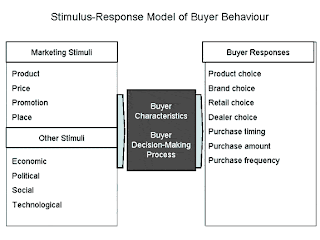

We were talking about values as well.
Value is an abstract and complex construct that can provide underlying continuity to behavior (Pitts and Woodside 1984)
"Values may prove to be one of the most powerful explanations of, and influences on, consumer behavior. They can perhaps equal or surpass the contributions of other major constructs including attitudes, product attributes, degrees of deliberating, product classification, and life style
Therefore, the consumption of a product can express or fulfill a certain value.
Consumers' preferences for certain values are likely to be expressed through consumption."
For example, certain products and activities may be preferred by a person who values excitement (e.g.fast cars). On the other hand, a person placing security as very important would be likely to have a different set of preferred products and activities (e.g.an airbag in their car). Researchers have suggested that we need "a better understanding of the links between values and behaviours, and special consideration of how values interact with situations"(Beatty et al. 1985).
To study consumption related values, Kahle (1983) modified the Rokeach Value Survey (RVS) into a smaller subset of values that were person oriented and generalizable across many activities. The List of Values (LOV) includes:
•sense of belonging
•excitement
•fun and enjoyment
•warm relationships with others
•self fulfillment
•being well respected
•a sense of accomplishment
•security
•self respect
Ruth asked about our values. Most of the group said: fun and enjoyment or family but foreign students consider security and sense of belonging as the most important values.
There are several interesting parallels between emotions and values. Psychologists (Tolman 1951; Izard 1977)agree that both emotions and values play an extremely important role in behavior.
Values are central beliefs expressed through specific behaviors (Rokeach 1973) and emotions are feelings linked to specific behaviors (Gardner 1985).
More about values: http://www.gentleye.com/research/cb/acr/acr1993.html
As it turned out, laddering techniqes are also very important in our life.
Laddering techniques enable us to identify the links between functional product attributes & desired end states
Laddering is used within two streams of research: Consumer research and organization research
•Consumer research to elicit consumers’ preferences towards certain products or services.
•Consumers’ preferences are categorized into three dimensions:
–Attributes of a product/service
–Consequences
–Values


To find out more about laddering techniques just read this article: http://www.epistemics.co.uk/Notes/178-0-0.htm
During the lecture, Ruth asked us to do 2 tests.
According to Harvard project test I have an automatic association between men and exact sciences and women and humanities. I did also another test. As I found out I have an automatic preference for slim people in comparison with overweight people. I hope it's a mistake because I know that discrimination against weightism is very unfortunate and people should be respected based on who we are and not how we look.
I did also the second test.
My primary VALS type is Achiever, and my secondary type is Experiencer.
The primary VALS type represents my dominant approach to life. The secondary classification represents a particular emphasis I give to my dominant approach.
According to online Dictionary achiever is “a person with a record of successes.”
The value of achievement lies in the achieving.
Albert Einstein
We were also asked to prepare our own TimeLine with the key events that made an impact on us. I divided it into events important to me and my country.
Key events for Poland:
•Barack Obama - President of the United States - 2009
•Poland in Schengen zone - 2007
•Lech Kaczyński – President of Poland - 2005
•Polish Pope’s death- 2005
•Poland in UE - 2004
•Adam Małysz – world’s champion in ski jumping - 2001
•WTC- terrorists attack, 2001
•Poland in NATO 1999
•Diana’s death - 1997
•Aleksander Kwaśniewski –President of Poland – 1995
Key events of my life:
•Studying time! - Bucks New University - 2008
•Mature exam - 2008
•The title of the student of the year at the end of the High School- 2008
•Driving licence – 2008
•My 18th birthday - 2008
•The last competition :( - 2007
•Buying my lovely dog - 2007
•Singing during the review of young talent - 2007
•Champion in the school dancing marathon - 2007
•First Certificate in English - 2007
•First earned money – 2006
•High school - 2005
•First date with my present boyfriend :) - 2005
•Best life result in the long jump (5,39m) - 2004
•2nd place in the Junior Championships of province in the long jump – 2002
•Champion of town and region in my leading sports disciplines (the long jump, the 100 meters sprint and the 4 x 100m relay race) - 2002
•Grandma's death - 2002
•First light athletics competition - 1999
•Sister’s birth - 1993














